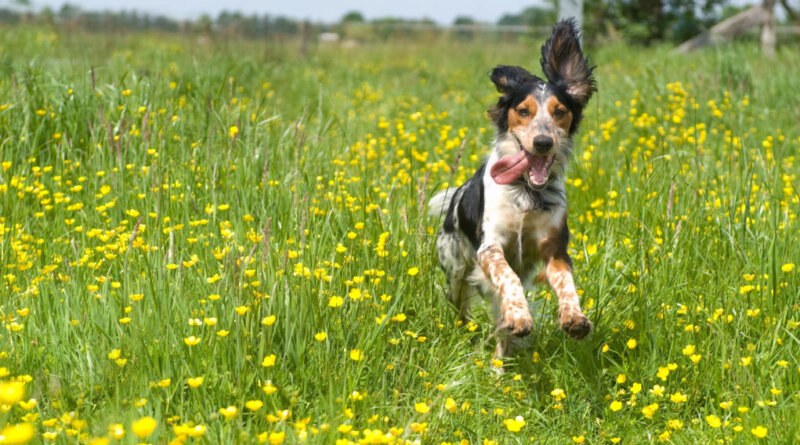How to Deal with It – Top Dog Tips
A chilling winter may rob your dog of the freedom to roam outside. But not its fiery impulse to go out.
So, as the first spring day thaws the last pile of snow, it also bolts your dog into an excited frenzy.
This may have been the first time you’ve noticed its sudden burst of energy as the spring season is starting.
And with that, you begin asking yourself, “Is spring fever in dogs a real thing?”
In this blog, we’ll discuss everything that you need to know about spring fever in dogs.
Do dogs get spring fever? How long does spring fever last in dogs?
We’ll answer all those questions about spring fever for dogs! Aside from that, we’ll talk about how to deal with dog spring fever.
Without further ado, let’s start!
Spring Fever in Dogs: What is it?
Dog spring fever pertains to the psychological response of dogs to changing climates, specifically from winter to spring.
We humans also suffer from spring fever too! But unlike humans, however, dogs will experience spring fever stronger.
This is because dogs have heightened senses which are far more powerful than humans.
So, how long does spring fever last in dogs?
Typically, spring fever last throughout the whole spring! This means that your dog may stay energetic starting from March to February.
How Do Dogs Get Spring Fever?
You may be wondering how dogs get spring fever.
Spring fever for dogs doesn’t work like a microbial infection where the symptoms manifest after contracting the disease.
Instead, spring fever in dogs comes from a myriad of factors that the changing season has brought.
These factors can be narrowed down to temperature increase, the smell of spring air, wild creatures coming out, and sunlight.
Increase in Temperature
Outdoor temperature can be a powerful mood changer for dogs.
The right warmness of the environment can stimulate the dog’s body to produce hormones that govern a happy mood.
When hit with a pleasant wave of warmth, your dog feels happier, more optimistic, and more active.
This preferred temperature is only attainable during the spring and summer seasons. That is why your dogs like to go outside during these warm seasons.
Spring Air Smell
Spring season is the time of the year when plant life begins to grow again.
Patches of grass will start to sprout again, trees will grow their leaves, and flowers will bloom again.
On top of that, the soil will smell during spring rains, while trees will give off a woody scent during sunny days.
All of these spring elements give off odors that are musky, woody, earthy, and even sweet.
Dogs would be able to perceive this distinct smell of time circulating in the spring air.
However, the varying aromas wafting in the air may come as a strong and overpowering scent for many dogs in some cases.
Wild Creatures
Your dog’s not the only creature that’ll come out as spring comes.
Just like the blooming plant life, wild animals will spring back to life once the winter’s over.
These wild animals crawl out of their slumber after their hibernation session ends.
A lot of these small critters are nimble creatures that are also excited to explore the post-winter environment.
These are common wildlife activities that they carry out once spring starts.
The problem with wildlife, however, is that they become bothersome, especially in human-populated areas like urban regions.
These wild animals may trigger behavioral responses from your dogs if they come in close contact with them.
Presence of Sunlight
Did you know that sunlight can do more to cause spring fever in dogs?
Besides raising the heat to arouse your dog’s mood, sunlight can affect the energy of your dog.
Basically, the more sunlight exposure your dog has, the more they become active.
And since there is more daytime in spring than in winter, expect a significant boost in your dog’s activeness.
What Are the Dog Spring Fever Symptoms
Spring fever can cause a drastic behavioral change in dogs. You can easily tell if your pet dog is experiencing symptoms of spring fever.
While these symptoms vary per dog, the common element in spring fever dogs is their hyperactivity.
Increased Energy Level
As mentioned, a healthy dosage of sunlight exposure for your dog can make them significantly active. But how?
This energy boost happens because of the shift of melatonin amount in your dog’s body.
Melatonin is the hormone that compels your dog to sleep. The more melatonin your dog has in its body, the easier it is for it to feel sleepy.
It is also a hormone that’s present in the human body too.
During the winter season, when there’s little sunlight, melatonin accumulates in the dog’s system. This makes the dog less active and even sleepy.
In springtime, however, when the sun shines better, the sunlight reduces melatonin production in dogs.
RELATED: WHY AND HOW MUCH DO DOGS SLEEP?
Earlier Wake-Up Time
Ever noticed a change in your dog’s sleep cycle? Like how your dog woke up earlier in springtime than it did when it slept in winter?
You can also blame sunlight for that.
Like the melatonin level in dogs, your dog’s circadian rhythm responds to sunlight as a signal to stay awake and alert.
This is where spring comes into play.
During springtime, the daytime becomes longer, which means there’s earlier sunlight exposure in the spring season than in winter.
Essentially, spring shifts your dog’s sleep cycle backward and makes earlier wake-up call time for the dog.
RELATED: DO DOGS HAVE A SENSE OF TIME?
Agitation
You may also observe that your dog easily shows signs of hostility during spring.
This agitation may come from your dog’s sudden territorial behaviors against wild creatures.
Wild animals like birds, raccoons, and squirrels explore right after the spring season starts.
Coincidentally, they invade areas like your lawn or backyard, where they become an annoyance as they occupy the space.
This triggers your dog to be protective of its assumed territories. Worse is when your dog shows aggression as a means to thwart them out of its space.
Unfortunately, their agitation may be challenging to manage. So, you might need extra patience and effort in training your pooch at this time.
It may even bare its irritated agitation to you!
Heightened Curiosity
From the smell alone, spring aromas can overwhelm your dog’s senses.
Our pet dogs can smell better than us because they have much more smelling receptors compared to us.
They also have a larger region of their brain that processes what their odor receptors have detected.
This exceptional smelling ability can pose problems during springtime.
At some point, these spring scents can arouse curiosity in your already overstimulated pet.
It even causes a sensory overload that can confuse your dogs and even irritate them.
Furthermore, small critters entice the predator instinct of dogs to chase. Their movements excite dogs to copy their energy and chase after them.
Overheating
Dogs can experience overheating during springtime.
Because of its hyperactivity, your dog will roam around the vicinity to experience the new season.
All these running, chasing, and excitement will produce body heat for your dogs.
Furthermore, the heat from the sun can add up and build stress on your dogs.
If you don’t cool down your dog, it can suffer from heat stroke and other serious health concerns.
How Do You Deal with Spring Fever in Dogs?
Spring fever seems like an inevitable inconvenience for dog owners like you. But fortunately, there are many ways to handle your spring fever dogs.
You’d be surprised to learn that this unavoidable spring trouble has some easily actionable steps that you can do.
So how do you deal with spring fever in dogs?
Stimulating Your Dog
If you continue to let springtime elements stimulate your dog, you’ll lose control over your dog.
To deal with the chase triggers during spring, you can intentionally stimulate the dogs yourself.
Preparing mental stimulation for your dog redirects all of their impulsive tendencies from the spring elements to yours.
These stimulations can be in the form of an object or activity as long as you can pique their interest.
Some good examples of stimulating objects are:
- Chew toys
- Dog puzzles
- Food
Meanwhile, below are some good examples of dog spring activities that are mentally stimulating to dogs:
- Dog walk
- Introducing a trick
- Completing an obstacle course
Practice Recall Training
Effective recall training can prove to be helpful in situations where your dog is wandering off.
Reliable recalls mean that there’s almost a guarantee that your dog will come to you when you call it.
Even if your dog is interacting with the various stimuli of nature, a recall should cue them to return to you at your call.
So how do you train your dog for recalls?
To start, you can show them a treat, a toy, or an object that would make your dog approach you.
If it comes close, reward them with praises to reinforce that behavior so that they’ll keep on doing it.
Eventually, you should add verbal commands like “come here,” “go here,” or even “here.”
From then, you can add difficulty in training by adding distance or recalling them first before the reward. You can also try recalling them in a high-distraction environment like parks.
Continue adding layers of difficulty in the recall training until you don’t need the treat to incentivize your dog to come back.
Take Your Dog for a Walk
Walking is one of the easiest, safest, and best exercises for your dogs. Lucky for you, it also is an activity that you can implement when your dog is experiencing spring fever.
Because walking is a physical activity, it expels the excess energy that your dog has this spring.
Walking may look like it’s not enough as exercise, but it does keep your dog’s excitement at bay.
Aside from it being a physical exercise, taking your dog for a walk is also a mental exercise for them.
As you walk your dog to a destination, it will be encountering more stimuli and chase triggers.
But with your leash in place, it will be a mentally challenging stimulation for your dog to control their impulses while walking.
Think of it as a detox session for your dog.
Spring Fever in Dogs: Dangers of Spring
Spring doesn’t only bring just more sunlight to your dogs but dangers as well!
And with your spring fever dog carelessly acting on its impulse, it’s recklessly at risk of various dangers of spring.
Here are some environmental risks and dangers that your dogs may encounter during their spring fever instances.
Allergies
Spring brings a lot of allergens into the air, which your dog can pick up as it explores the recent season change.
Pollens alone from the sprouting flowers are enough to trigger your dog’s allergy.
If these flower particles can cause you to sneeze profusely, imagine how these pollens can put your dog in a discomforting state.
Your dogs can also get allergies from insect bites like mosquitoes, bees, and even ants.
Furthermore, mites, fleas, and even lice are allergens themselves. Even the slightest contact with them will trigger your dog’s immune system and cause inflammation.
Some of the signs that your dog has spring allergies are:
Toxic Plants
Aside from allergies, there are specific plants that can inflict direct health issues on your dog once ingested.
These plants have substances or compounds that are specifically toxic to dogs.
Unfortunately, unsuspecting dogs would likely come across these plants more often and ingest them.
Some toxic plants and flowers that you need to look out for during springtime are:
- Tulips
- Daffodils
- Lilies
- Rapeseed
- Bluebells
RELATED: THE ULTIMATE LIST OF TOXIC AND SAFE PLANTS, SEEDS FOR DOGS
Additionally, here are some symptoms of plant poisoning in your dog:
- Vomiting
- Diarrhea
- Seizures
- Mouth foaming
If in case your dog has ingested these plants, you should monitor their condition and take them to your local vet if symptoms worsen.
Parasites
Parasites are ever-abundant when spring comes. They, like any other creatures, will bounce back to life right after the winter ends.
Dogs that are exploring the new spring environment can pick up these parasites on the ground or in contaminated water.
Sometimes, a dog can get external parasites like ticks and fleas from an infected dog or a wild furry creature.
Eventually, these parasites will reproduce in dogs and would bring serious health issues to them.
Wild Predators
It turns out that dogs are not at the top of the food chain.
The spring season does not only put an end to small critters’ hibernation but large predators’ too.
You would mostly encounter them during spring hikes or when your house is near the woods.
While these predators do not usually prey on dogs, running into them usually leads to dog mortality.
Small dog breeds like Chihuahuas and Terriers will be an easy feast for a lot of carnivorous predators.
Larger dog breeds, on the other hand, are prone to predator aggression, assault, and even injuries.
Some of the large predators that you should look out for are:
- Wolves
- Foxes
- Coyote
- Snakes
- Bears
- Bobcats
Physical Injuries
High energy levels, combined with peak curiosity, spell recklessness and danger for your dogs.
Right when your dog is chasing an object, your pet will pour its focus on its target. It will disregard its surroundings and even its safety.
Because of this, a lot of dogs will bump into obstacles and even crash. In some cases, dogs will even fall from a high place after chasing down their targets.
All of these mishaps can cause serious physical injuries to your dogs. These dog injuries range from bruises, swelling, and even broken bones.
Spring Fever in Dogs: Summary
Spring fever in dogs is not a myth, and its symptoms may appear on your dog once the snow starts to melt.
These prominent causes of spring fever in dogs are longer daytime and excess stimulation to your dog’s senses.
And while calming your dog’s spring-induced hyperactivity can be a daunting task, it doesn’t have to be.
With proper recall training and intentional mental stimulation, you can now counter the effects of spring fever.
Be consistent with these actions, and eventually, you will have better control of your pet’s impulsive behavior during springtime.
READ NEXT: SPRING SHEDDING: HOW TO DEAL WITH SPRINGTIME DOG SHEDDING









